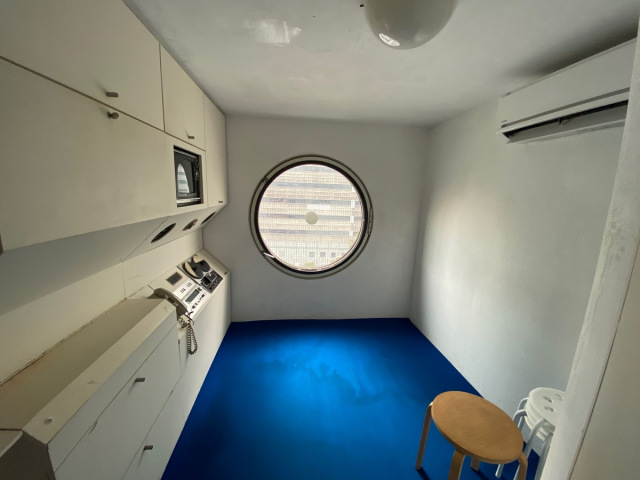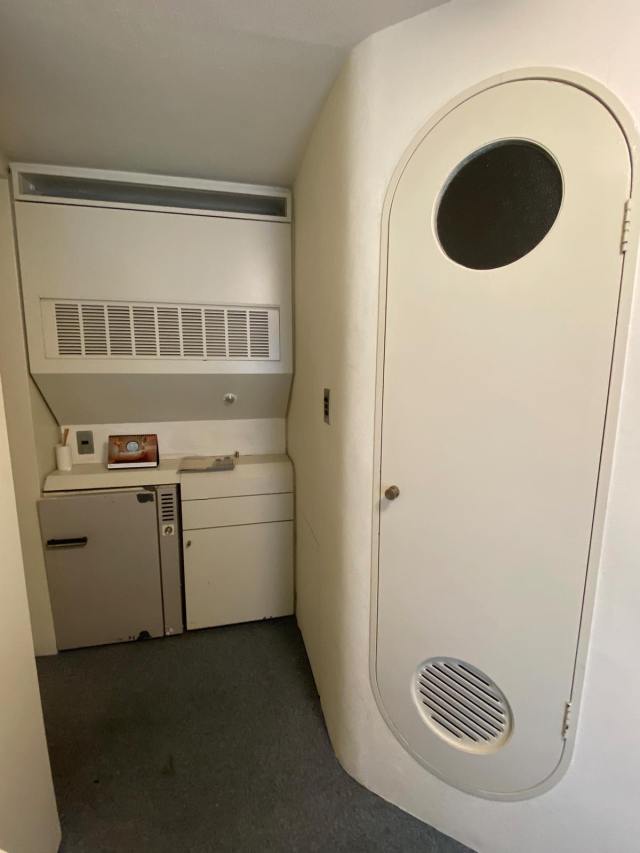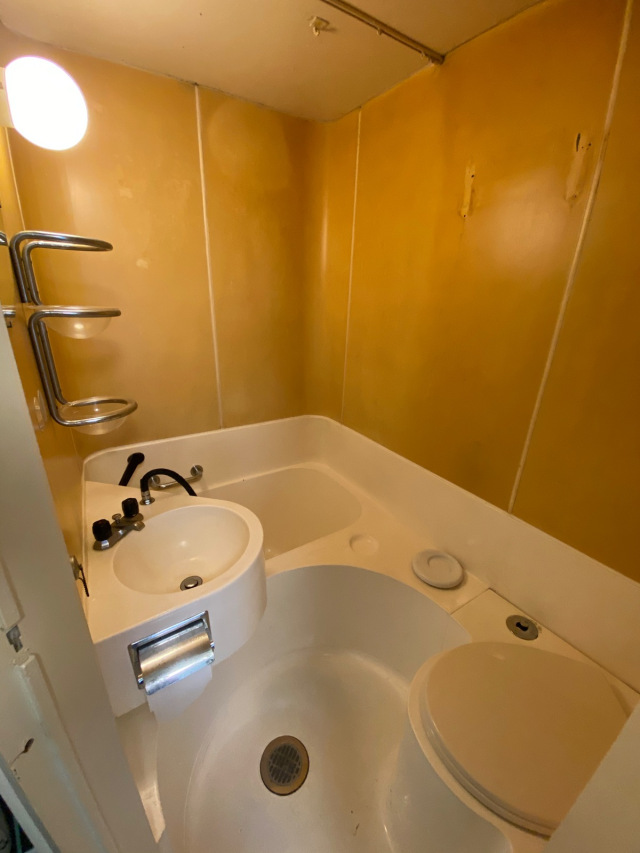
We move into a capsule apartment in the iconic landmark, and find out it’s not all it’s cracked up to be.
Tokyo is just as well-known for its ancient shrines and temples as it is for its bright, modern neon screens, but there are a lot of buildings in the city that sit in between these disparate time frames.
Nakagin Capsule Tower is one such building, glistening as a futuristic marvel of modern architecture and catching everyone’s eye with its unusual cubic design when it was first erected in 1972. Now, 49 years after it first sprang to life, the ageing building, which houses 140 self-contained prefabricated capsules, faces the threat of being demolished, after the majority of capsule owners voted to tear the complex down in 2007 and replace it with a more modern tower.
▼ Nakagin Capsule Tower was designed by Japanese architect Kisho Kurokawa
After Kurokawa opposed the demolition, and suggested instead that the prefabricated capsules inside the complex be replaced with more modern ones, plans were stalled and Masato Abe, a capsule owner who once lived in the building, founded the “Save Nakagin Tower” project.
As part of its preservation plans, the “Save Nakagin Tower” project has been leasing around 30 capsule apartments to the public on a monthly basis since 2018. However, these monthly stays were temporarily closed recently, which came as sad news to our Japanese-language reporter Chie Nomura, who had been waiting to rent one of these apartments. She managed to get in contact with Tatsuyuki Maeda, a representative from the organisation, to let him know her desire to live in the tower, and after a few days passed, she was thrilled when he called her back to let her know an apartment had become available.
▼ Nomura has long been a fan of the alternate-world-retro-sci-fi-looking building.
So Nomura gathered a month’s worth of essentials together and made her way to the twin towers, located conveniently close to Shimbashi Station and within walking distance of the fashionable Ginza district.
▼ The entrance to the Nakagin Capsule Tower Building looks a little run-down, but that’s part of its charm.
Standing at the entrance, Nomura looked up and realised she’d never viewed the building from this angle before. She loved its unusual silhouette and thought it would be a shame if a building like this were to hit the dust and be replaced with a cold, characterless building.
It didn’t take long for Nomura to be shown to her room, and as soon as she stepped into the prefabricated capsule, she was pleased to find it was everything she’d hoped it would be.
▼ The room looked like a spaceship, and the star of the show was the unique circular window.
It certainly wasn’t big, but that was to be expected from a capsule apartment, and Nomura wasted no time in unpacking the box of goods she’d brought with her to help her settle in for a month in the room.
▼ Nomura’s essentials included a few of her favourite soft plushies to keep her company.
The retro vibe here was strong, extending to the original introductory booklet which Nomura found on a side table inside the room. According to the information in the booklet, the Nakagin Capsule Tower Building actually consists of two interconnected cement towers, one 11 stories high and the other 13, with prefabricated capsule “plugs” that can be used as residences or offices.
▼ The original idea was to provide Tokyo office workers with a place to stay during the week to avoid long commutes back home.
After spending a few days in her apartment, Nomura discovered it came with a variety of pros and cons, so let’s take a look first at the upsides of living in the iconic tower. Of course, the top reason for staying here is the convenient location and the chance to step back in time and enjoy the retro atmosphere inside an architecturally respected landmark in Tokyo.
▼ This image, of another apartment inside the tower, shows a room that most closely resembles the original when it was completed in the ’70s.
One of the most iconic aspects of the building is the round windows that adorn each cube. Nomura loved the design aesthetic, and spent a lot of time gazing out of that round window from the cosy comfort of her bed.
▼ The wall storage system is incredibly retro, with a desk that conveniently pulls down when you need to use it…
▼ …And the door on the right conceals a closet with a good-sized mirror.
And what about this Sony reel-to-reel tape recorder? These were a high-end way to play and record music in the ’60s and ’70s, and although this one didn’t seem to work when Nomura fiddled with it, she was fascinated to see it was still included in all the rooms.
▼ It’s not every day you get to stay in a room with a built-in open-reel recorder from the ’70s.
▼ The rounded door to the bathroom was also a retro lover’s dream.
While the upsides to her stay were the prestige of staying inside the complex, the convenience of its location, and its gorgeous retro design, the room isn’t without its pitfalls. The most obvious downside is the fact that there’s no kitchen inside the room (portable gas stoves aren’t allowed either as open fires are prohibited) and the bar fridge (seen in the photo above) doesn’t work, which means you’ll be eating out or dining in on ready-made store-bought meals during your month-long stay.
Perhaps the biggest inconvenience, however, is the fact that hot water to the rooms was shut off in 2010 after one of the water pipes burst in the building. That means there’s no hot water in the bathroom, but there is a shared shower room on-site so you won’t have to stink the place out for a month.
▼ No running hot water might be a pain in winter, but it isn’t so bad in summer
▼ The bathroom still works fine, and is pretty cute to boot.
There are also no washing machines in the building, so Nomura would have to use a laundromat outside the complex to wash her clothes during her stay. According to Google Maps, the nearest laundromat was a 16-minute walk away, but she was up for the adventure.
Nomura is only a few days into her stay at the moment, so she’ll be updating us with her final verdict on her experience once she checks out of the tower in a few weeks’ time.
▼ Until then, she’ll be perfecting her Instagram poses in front of that iconic window and living her best ’70s bohemian life.
Stays in the 10-square-metre (107-square-foot) rooms are priced at 120,000 yen (US$1,070), which works out to roughly 4,000 yen a night, making the capsule apartments much more affordable than standard hotel rooms in the city.
While the rooms aren’t available to rent at the moment, there’s a high likelihood they’ll become available in the near future, so you too can live the high life like Nomura. Watch this space for her next update, which will include tips for those considering a stay there, and more information on the fate of the building, which is currently on tenterhooks.
Information
Nakagin Capsule Tower Building / 中銀カプセルタワー
Address: Tokyo-to, Chuo0ku, Ginza 8-16-10
東京都中央区銀座8-16-10
Website
Photos ©SoraNews24
● Want to hear about SoraNews24’s latest articles as soon as they’re published? Follow us on Facebook and Twitter!
[ Read in Japanese ]



















 Nakagin Capsule Tower in Tokyo is scheduled to be demolished, needs your help
Nakagin Capsule Tower in Tokyo is scheduled to be demolished, needs your help Nakagin Capsule Tower’s rare “pink capsules”, formerly used in the sex industry
Nakagin Capsule Tower’s rare “pink capsules”, formerly used in the sex industry Restoring Nakagin Capsule Tower’s rare “pink capsule”, formerly used in the sex industry
Restoring Nakagin Capsule Tower’s rare “pink capsule”, formerly used in the sex industry The anime cosplay DJ in Tokyo’s crazy Nakagin Capsule Tower apartment【Photos】
The anime cosplay DJ in Tokyo’s crazy Nakagin Capsule Tower apartment【Photos】 Nakagin Capsule Tower’s last residents: group meals, floods, weird noises, and more
Nakagin Capsule Tower’s last residents: group meals, floods, weird noises, and more Should you dip your cake in sake? One Japanese brewer says no, but actually yes【 Taste test】
Should you dip your cake in sake? One Japanese brewer says no, but actually yes【 Taste test】 The one and only master of train station packing-tape calligraphy shares his story and inspiration
The one and only master of train station packing-tape calligraphy shares his story and inspiration Japan’s number-one cosplayer Enako creates jaw-dropping crowd at Winter Comiket【Photos】
Japan’s number-one cosplayer Enako creates jaw-dropping crowd at Winter Comiket【Photos】 Survey says osechi New Year’s food differs according to each region in Japan
Survey says osechi New Year’s food differs according to each region in Japan All aboard Tokyo’s newest English-playable real escape game! We try Escape from the Runaway Train
All aboard Tokyo’s newest English-playable real escape game! We try Escape from the Runaway Train The Purple Lucky Bag from Village Vanguard is an extra-large waste of money
The Purple Lucky Bag from Village Vanguard is an extra-large waste of money We travel to Yamanashi to try the water cake that disappears in 30 minutes!【Taste Test】
We travel to Yamanashi to try the water cake that disappears in 30 minutes!【Taste Test】 Osaka to Fukuoka for less than 40 bucks? It’s possible with Japan’s overnight ferry
Osaka to Fukuoka for less than 40 bucks? It’s possible with Japan’s overnight ferry Dragon Quest Burgers and Slime drinks are coming to McDonald’s Japan【Video】
Dragon Quest Burgers and Slime drinks are coming to McDonald’s Japan【Video】 Private booths are coming to Japan’s Shinkansen bullet trains even sooner than we’d thought【Video】
Private booths are coming to Japan’s Shinkansen bullet trains even sooner than we’d thought【Video】 Starbucks Japan ready to get Year of the Horse started with adorable drinkware and plushies【Pics】
Starbucks Japan ready to get Year of the Horse started with adorable drinkware and plushies【Pics】 Hayao Miyazaki says Happy New Year to Studio Ghibli fans with new art for Year of the Horse
Hayao Miyazaki says Happy New Year to Studio Ghibli fans with new art for Year of the Horse Japanese beef bowl chain Sukiya’s 2026 Smile Box lucky bag basically pays for itself
Japanese beef bowl chain Sukiya’s 2026 Smile Box lucky bag basically pays for itself We found possibly the quietest Japanese-style hotel in Tokyo’s bustling Shinjuku district
We found possibly the quietest Japanese-style hotel in Tokyo’s bustling Shinjuku district Cup Noodle tries an authentic Jiro-style ramen, but something’s not quite right
Cup Noodle tries an authentic Jiro-style ramen, but something’s not quite right The best Starbucks Japan Frappuccinos we want to drink again in 2026
The best Starbucks Japan Frappuccinos we want to drink again in 2026 We revisited Sweets Paradise after a decade to see if Japan’s dessert buffet still delivers
We revisited Sweets Paradise after a decade to see if Japan’s dessert buffet still delivers That time Seiji called JASRAC to ask why he didn’t get paid royalties for his song being on TV
That time Seiji called JASRAC to ask why he didn’t get paid royalties for his song being on TV Japan’s oldest largetooth sawfish in captivity back on display in Mie Prefecture
Japan’s oldest largetooth sawfish in captivity back on display in Mie Prefecture Pizza Hut Japan’s hot lucky bags are perfect for a New Year’s pizza party
Pizza Hut Japan’s hot lucky bags are perfect for a New Year’s pizza party 7-Eleven Japan starts new temporary luggage storage service in over 300 branches
7-Eleven Japan starts new temporary luggage storage service in over 300 branches Disillusionment at Tsukiji’s tourist-target prices led us to a great ramen restaurant in Tokyo
Disillusionment at Tsukiji’s tourist-target prices led us to a great ramen restaurant in Tokyo Starbucks teams up with 166-year-old Kyoto doll maker for Year of the Horse decorations【Photos】
Starbucks teams up with 166-year-old Kyoto doll maker for Year of the Horse decorations【Photos】 Tokyo considering law requiring more trash cans following litter increase in heavily touristed area
Tokyo considering law requiring more trash cans following litter increase in heavily touristed area Tokyo’s Tsukiji sushi neighborhood asks tour groups to stay away for the rest of the month
Tokyo’s Tsukiji sushi neighborhood asks tour groups to stay away for the rest of the month Tokyo event lets you travel back in time, for free, to celebrate 100 years since Showa era start
Tokyo event lets you travel back in time, for free, to celebrate 100 years since Showa era start Japan may add Japanese language proficiency, lifestyle classes to permanent foreign resident requirements
Japan may add Japanese language proficiency, lifestyle classes to permanent foreign resident requirements Sanrio theme park in Japan announces plans to expand into a Sanrio resort
Sanrio theme park in Japan announces plans to expand into a Sanrio resort Stamina-destroying “Paralysis Noodles” are Tokyo’s newest over-the-top ramen innovation
Stamina-destroying “Paralysis Noodles” are Tokyo’s newest over-the-top ramen innovation Survey asks foreign tourists what bothered them in Japan, more than half gave same answer
Survey asks foreign tourists what bothered them in Japan, more than half gave same answer Japan’s human washing machines will go on sale to general public, demos to be held in Tokyo
Japan’s human washing machines will go on sale to general public, demos to be held in Tokyo Japan’s deadliest food claims more victims, but why do people keep eating it for New Year’s?
Japan’s deadliest food claims more victims, but why do people keep eating it for New Year’s? We deeply regret going into this tunnel on our walk in the mountains of Japan
We deeply regret going into this tunnel on our walk in the mountains of Japan Studio Ghibli releases Kodama forest spirits from Princess Mononoke to light up your home
Studio Ghibli releases Kodama forest spirits from Princess Mononoke to light up your home Major Japanese hotel chain says reservations via overseas booking sites may not be valid
Major Japanese hotel chain says reservations via overseas booking sites may not be valid Put sesame oil in your coffee? Japanese maker says it’s the best way to start your day【Taste test】
Put sesame oil in your coffee? Japanese maker says it’s the best way to start your day【Taste test】 No more using real katana for tourism activities, Japan’s National Police Agency says
No more using real katana for tourism activities, Japan’s National Police Agency says Starbucks Japan reveals new sakura drinkware collection, inspired by evening cherry blossoms
Starbucks Japan reveals new sakura drinkware collection, inspired by evening cherry blossoms Updated cherry blossom forecast shows extra-long sakura season for Japan this year
Updated cherry blossom forecast shows extra-long sakura season for Japan this year Tokyo’s famous capsule apartments now take month-long reservations from foreign travelers
Tokyo’s famous capsule apartments now take month-long reservations from foreign travelers Save the Nakagin Capsule Tower Project is now aiming to preserve as many capsules as possible
Save the Nakagin Capsule Tower Project is now aiming to preserve as many capsules as possible 200,000 yen-per-night Airbnb is the successor to Tokyo’s famous Nakagin capsule apartments【Pics】
200,000 yen-per-night Airbnb is the successor to Tokyo’s famous Nakagin capsule apartments【Pics】 Japanese company starts project to restore Nakagin Capsules to capsule hotel
Japanese company starts project to restore Nakagin Capsules to capsule hotel Do Tokyo’s Reversible Destiny Lofts really hold the power to reverse your destiny?
Do Tokyo’s Reversible Destiny Lofts really hold the power to reverse your destiny? Testing out Japan’s portable no-electricity multi-function washing/drying machine【Pics】
Testing out Japan’s portable no-electricity multi-function washing/drying machine【Pics】 Reversible Destiny Lofts needs your help to protect its destiny during coronavirus pandemic
Reversible Destiny Lofts needs your help to protect its destiny during coronavirus pandemic Tokyo accommodation: Capsule hotel offers unique sleep and sauna stay for women
Tokyo accommodation: Capsule hotel offers unique sleep and sauna stay for women Is this cheap, US$20-a-night capsule hotel in Tokyo’s Kabukicho a good-value stay?
Is this cheap, US$20-a-night capsule hotel in Tokyo’s Kabukicho a good-value stay? Capsule hotel offers stays for $12 a night, extra perks make it one of the best deals in Tokyo
Capsule hotel offers stays for $12 a night, extra perks make it one of the best deals in Tokyo This Japanese capsule hotel tells you how many times you snore during the night
This Japanese capsule hotel tells you how many times you snore during the night Stay at a Japanese capsule hotel in Tokyo for less than US$20 a night
Stay at a Japanese capsule hotel in Tokyo for less than US$20 a night Capsule hotel in Tokyo offers spa stay, with sauna and infrared foot bath to wash stresses away
Capsule hotel in Tokyo offers spa stay, with sauna and infrared foot bath to wash stresses away This northern Tokyo capsule hotel is cheap, clean, comfortable, and has amazing amenities
This northern Tokyo capsule hotel is cheap, clean, comfortable, and has amazing amenities Sleep in a futuristic space pod at this interstellar capsule hotel just outside of Tokyo
Sleep in a futuristic space pod at this interstellar capsule hotel just outside of Tokyo Free alcohol and curry make this cheap capsule hotel near Shinjuku Station a great place to stay
Free alcohol and curry make this cheap capsule hotel near Shinjuku Station a great place to stay Stay in an eerie Japanese ryokan inn near Tokyo Tower for US$40 a night
Stay in an eerie Japanese ryokan inn near Tokyo Tower for US$40 a night
Leave a Reply